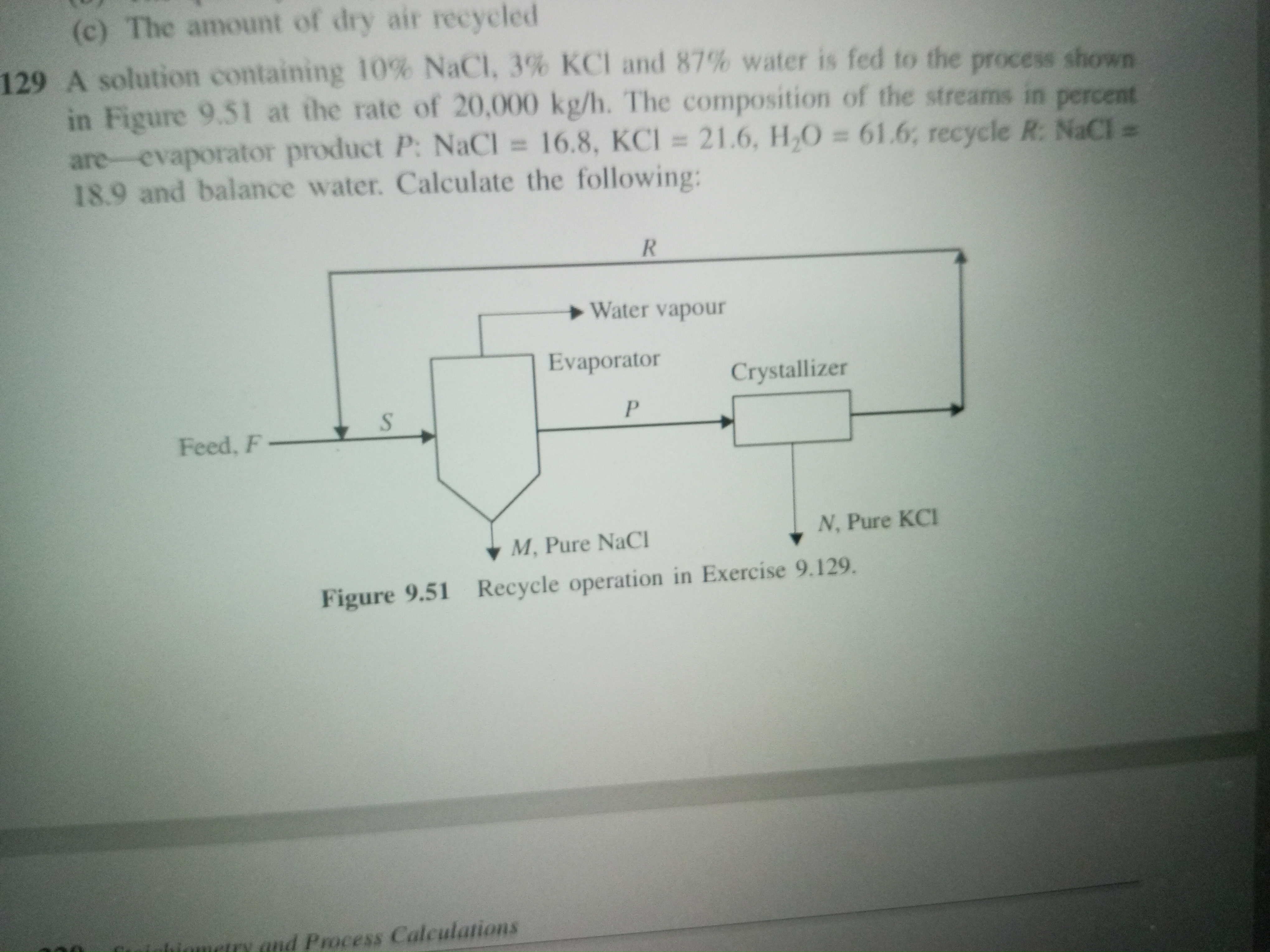A solution containing 10% NaCl, 3% KCl and 87% water is fed to the process shown in Figure 9.51 at the rate of 20,000 kg/h. The composition of the streams in percent are – evaporat... A solution containing 10% NaCl, 3% KCl and 87% water is fed to the process shown in Figure 9.51 at the rate of 20,000 kg/h. The composition of the streams in percent are – evaporator product P: NaCl = 16.8, KCl = 21.6, H2O = 61.6, recycle R: NaCl = 18.9 and balance water. Calculate the following:

Understand the Problem
The question requires calculations related to a chemical engineering process involving the separation of components in a solution, specifically NaCl and KCl, using an evaporator and a crystallizer. It outlines the composition of the feed and products and asks for specific calculations based on the given data.
Answer
The mass of dry air recycled is determined through water balance specifically, with percentage compositions driving calculations. Final values depend on iterative solving of equations formed.
Answer for screen readers
Given the calculations set up in the steps, the specific numerical values for streams are:
- Mass of NaCl produced (M) = x kg/h
- Mass of dry air recycled = y kg/h (final values depend on iterations and specific compositions maintained).
Complete numerical solutions depend on substituting and resolving the equations from above, mainly relying on given percentages.
Steps to Solve
- Determine the mass flow rates of NaCl and KCl in the feed The composition of the feed solution is given as 10% NaCl and 3% KCl. Calculate the masses of NaCl and KCl in the feed:
-
Mass flow rate of the feed, $F = 20000 \text{ kg/h}$.
-
Mass of NaCl in the feed: $$ \text{Mass of NaCl} = F \times 0.10 = 20000 \times 0.10 = 2000 \text{ kg/h} $$
-
Mass of KCl in the feed: $$ \text{Mass of KCl} = F \times 0.03 = 20000 \times 0.03 = 600 \text{ kg/h} $$
- Calculate the mass balance for the evaporator Using the given product compositions for the evaporator and taking into account the recycle, set up a mass balance for NaCl and KCl. For NaCl, balance:
- Given:
- Mass of NaCl product, $P_{\text{NaCl}} = 16.8%$
- Mass of KCl product, $P_{\text{KCl}} = 21.6%$
- Water in product $= 61.6%$
Using the overall mass balance on NaCl: $$ F_{\text{NaCl}} + R_{\text{NaCl}} = P_{\text{NaCl}} + M $$
This relationship will help establish the total flow rate after separation.
- Calculate overall flow rates in the system Next, we need to find the total mass flow of recycled material $R$ and the product $M$. We can express the flow rate of the evaporator exit stream as:
- Mass balance relates these streams with: $$ R + P = F + S $$
Substituting known values:
- Set $R = R_{\text{NaCl}} + R_{\text{KCl}} + R_{\text{H2O}}$, iterate total balances for NaCl, KCl and water.
- Find the mass of product M (pure NaCl) Using a separate mass balance for NaCl in the crystallizer:
- Mass of pure NaCl produced, $M$. Assume that all NaCl is crystallized and collected, thus simplifying calculations.
- Calculate the amount of dry air recycled If we need to find the dry air recycling, balance on water vapour and moisture expressed in the evaporator, including how water exits to vapour.
Given the calculations set up in the steps, the specific numerical values for streams are:
- Mass of NaCl produced (M) = x kg/h
- Mass of dry air recycled = y kg/h (final values depend on iterations and specific compositions maintained).
Complete numerical solutions depend on substituting and resolving the equations from above, mainly relying on given percentages.
More Information
This problem deals with mass balances in a chemical process involving multiple components, which is critical in chemical engineering. Understanding how to set up these balances and working with component drawings is essential.
Tips
- Failing to account for all components in mass balances.
- Skipping proper units: always ensure units stay consistent throughout.
- Not setting up the relationships between recycle streams and products properly.
AI-generated content may contain errors. Please verify critical information